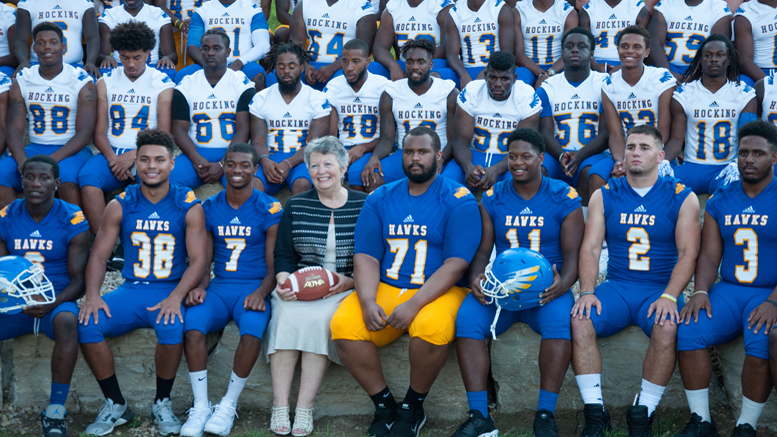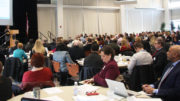A vote of no confidence needn’t be a kiss of death anymore for a college president, according to new research and feedback from seasoned community college leaders.
In fact, some of them, who have gone through the process themselves, say in certain cases it shows college boards that the CEO is willing to make tough and sometimes unpopular decisions when necessary.
These votes typically occur because “someone doesn’t like what you did, rather than because you did something wrong,” says Betty Young, who’s been through no-confidence votes at three separate colleges and currently serves as president of Hocking College in Ohio.
“Often, it’s a business decision that may have not given someone the result they wanted,” she says. “But all the public hears is a sound bite that seems really ominous.”
Young will speak about her experiences at a session at the American Association of Community Colleges’ (AACC) Annual Convention in New Orleans April 22-25, along with Robert Hill, associate professor of higher education leadership at Nova Southeastern University in Florida, and William Austin, president of Warren County Community College (New Jersey), and a member of the AACC board of directors.
On the rise
Research by Austin shows no-confidence votes against community college presidents have been more frequent since the Great Recession and are also more common in states with strong labor unions, such as New York, New Jersey, Ohio and Michigan. They are less likely to occur in right-to-work states, with Tennessee being an exception.
Austin found that 51 percent of presidents of AACC member colleges who had had been subject to a no-confidence vote since 2008 had stayed in office. Among those who left, only about 18 percent were fired or didn’t have their contracts renewed, and that was usually because of a scandal investigation or some other major problem. Most resigned, retired or took other jobs.
“You see this more in institutions going through significant change,” Austin says. Budget cutbacks were often a key factor, along with objections to curriculum changes, staffing cuts and financial management.
Other factors
Hill cites additional issues that could lead to a vote of no confidence: lack of transparency, not allowing faculty to participate in decisions, labor disputes, contract violations and increasing faculty workloads.
“Higher education is experiencing dramatic change, and we don’t handle change that well,” Hill says. “When faculty become frustrated – and feel they have less of a voice – this is one way to call attention to a problem.”
Something for everyone: With six pre-convention workshops, 245 forum sessions, 43 meetings, 10 “ED Talks” and 16 social events, there’s something for everyone at the 2017 AACC Annual Convention April 21-22 in New Orleans. Register today.
Instead of trying to work out conflicts informally, as had been the norm in the past, some faculty are now more likely to go for what he calls the “nuclear option.”
“Often it has to do with the magic word, which is communication,” Austin says. Faculty often feel like they weren’t consulted enough before the change. “But sometimes, when you do communicate, the receiver doesn’t like the message.”
“It’s become so much harder to be a president than it had been,” Austin says. “After the recession, more transparency and more accountability are required, while there’s been a decline of resources.” Faculty tend to blame a new president who imposes austerity measures, even though problems could have started under a previous administration.
Men vs. women
Austin also found a gender difference. Among all no-confidence votes, 68 percent were against male residents, while 32 percent involved females, which reflects the greater proportion of men in the president’s suite.
Those votes were harder to overcome for women, however, he says. For men, it’s more business oriented, while for women, it’s more personal.
There are several factors that make community college presidents more vulnerable to votes of no confidence than leaders at four-year institutions, Hill says.
Because community colleges focus on teaching rather than research, two-year college presidents face more pressure to ensure student success and retention, he notes. Declining state resources and the rise of performance-based funding have also put more pressure on college CEOs.
Holding strong
Young is outspoken about the issue because she wants presidents and boards to “know the reality of these actions and make better decisions about how to proceed.” She hopes boards won’t back away from hiring a president who’s been through this.
“I’m a pretty resilient person, and a pretty positive person,” Young says. “But I’ve watched a lot of people struggle.”
Young’s first no-confidence vote was about 10 years ago when she was president of Northwest State Community College in Ohio.
Gateway to the presidency: This year’s pre-AACC convention sessions include a workshop that will provide a valuable simulation of the presidency interview process and insights into how community college boards of trustees function. Register today.
The union threatened a no-confidence vote if the college failed to approve a contract, Young recalls. “It was a play in the Ohio Education Association’s playbook to put pressure on the organization to settle their contract.”
The board of trustees told Young she had the authority to negotiate a contract and, ultimately, gave her a raise for doing her job.
“This is about somebody bullying someone else,” Young says. “I’m not going to be bullied.”
Young stayed at Northwest a couple more years and, after a stint as president of Asheville-Buncombe Technical Community College in North Carolina, took a job as president of Coleman College for Health Sciences in the Houston Community College System (HCCS).
HCCS faced a budget shortfall and had to cut $32 million annually for two years, she says. Each president in the system was asked to reduce costs. Young proposed requiring department heads to do some teaching, and, “as you might expect, not everyone liked that.”
Because of the way the faculty senate was structured, it took very few people to orchestrate a no-confidence vote against Young.
Hard choices
She stayed at Coleman until a new chancellor was named, then accepted a position as interim president at Hocking College in fall 2014. The college faced a $4.4 million deficit – with a total budget of $32 million – just four months into the budget year.
“Enrollment had declined and there was a crisis in leadership,” she says. “That’s why they brought in an interim president. It was my job to clean it up.”
Young knew there was a big problem going in. “I don’t take easy jobs,” she says. “We fixed the institution,” although that meant layoffs and furloughs. “We didn’t have much choice about that; the college didn’t have enough reserves.”
The Hocking board invited Young to apply for the presidency.
“The board was satisfied with the direction they were going and didn’t want to change horses in the middle of the corrections that were happening,” she says.
The faculty, however, was unhappy with the budget and staff cuts, so they passed a no-confidence resolution, which Young says was done “as a precursor to going into union negotiations.” Despite the vote, the board awarded her a five-year contract.
Negotiations have been going on since last May.
“There’s still no contract, but the college is doing well fiscally and enrollment is up,” she says.
Surviving the vote
Young notes that many successful, nationally recognized community college leaders have faced no-confidence votes at some point in their careers and surpassed it based on their record and outcomes. She added that the process is being overused and used inappropriately.
“If someone is stealing from an organization or doing something unethical, those are different issues,” Young says. But using a no-confidence vote to attack someone for doing the work they were hired to do – like fix the budget or stop enrollment declines – is not appropriate. “I used to think it was resistance to change. Now I think it’s more about pushing a selfish agenda.”
The message to a president that “’if you don’t do what I want, I will attack you,’ is bullying, and that is not acceptable,” she says.
Head it off
Hill advises presidents to avoid this problem by building good relationships with faculty and maintaining good communications. “This doesn’t come out of the blue. It they’ve already scheduled a vote, it’s too late.”
After a vote, it’s going to be hard to lead, knowing the faculty’s feelings, Hill says. So the president needs to develop a plan to improve that relationship. It’s especially difficult when it’s the faculty’s strategy to make the vote public with the goal of “shaming the president in the local media.”
When a no-confidence vote seems unavoidable, Austin urges presidents to “make sure you communicate with the board so they understand why a decision was made and why a group isn’t happy about it.”
When people complain about low morale, he says, the message should be, “we’re not here to make people happy, we’re here to graduate students.”
“Is this a career killer? Absolutely not,” Austin says. “No-confidence votes don’t accomplish anything. Often it’s a referendum on change, rather than leadership.”
“If you’re doing the right thing to sustain the institution, maintain its integrity, and protect students from higher tuition, you’ll survive,” he says. “In the end, it’s about being a good leader.”



